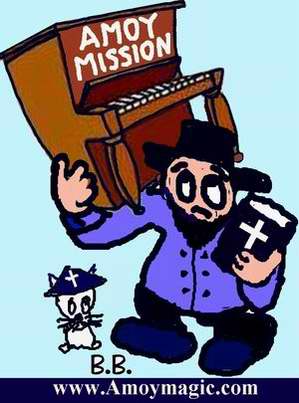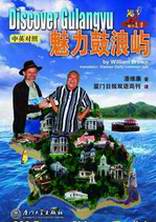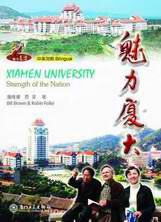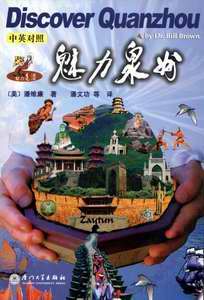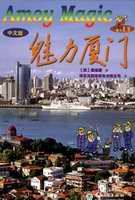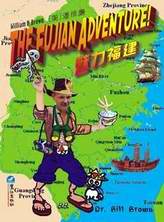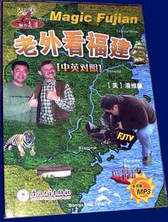![]() Click
to
Access
Click
to
Access
AMOYMAGIC SITE from
OUTSIDE China
![]() Click
to Access AmoyMagic
Site from
Click
to Access AmoyMagic
Site from
INSIDE
China
![]()
TRAVEL LINKS
![]() Xiamen
Xiamen
![]() Gulangyu
Gulangyu
![]() Jimei
Jimei
![]() Tong'an
Tong'an
![]() Jinmen
Jinmen
![]() Zhangzhou
Zhangzhou
![]() Quanzhou
Quanzhou
![]() Wuyi
Wuyi
![]() #1Fujian
Sites!
#1Fujian
Sites!
![]() Fujian
Foto Album
Fujian
Foto Album
![]() Books
on Fujian
Books
on Fujian
![]() Readers'Letters
Readers'Letters
![]() Ningde
Ningde
![]() Zhouning
Zhouning
![]() Longyan
Longyan
![]() Sanming
Sanming
![]() Putian
Putian
![]() Bridges
Bridges
![]() Travel
Info,
Travel
Info,
![]() Hakka
Roundhouses
Hakka
Roundhouses
![]() Travel
Agents
Travel
Agents
MISC. LINKS
![]() Amoy
People!
Amoy
People! ![]()
![]() Darwin
Driving
Darwin
Driving ![]()
![]() Amoy
Tigers
Amoy
Tigers
![]() Chinese
Inventions
Chinese
Inventions
![]() Tibet
in 80 Days
Tibet
in 80 Days![]()
![]() Amoy
Vampires!
Amoy
Vampires!
![]() Dethroned!
Dethroned!
![]()
![]() Misc.Writings
Misc.Writings
![]() Latest
News
Latest
News
![]() Lord
of Opium
Lord
of Opium
![]() Back
to Main Page
Back
to Main Page
![]() Order
Books
Order
Books![]() Xiamenguide
Forum
Xiamenguide
Forum
![]() Hill's
Photo Album
Hill's
Photo Album
![]() AmoyMission
Main Menu
AmoyMission
Main Menu
The Hill Family in Amoy
(Click thumbnails for
l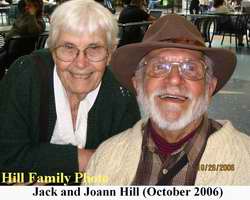 arger
photos)
arger
photos)
Part
1, by Jack Hill MD, Phd. (written
in 1st person to his children) Click
Here for Questions & Answers.
I [Jack Hill] went out to China as a medical missionary with the support
of the Mission Board of the Reformed Church in America. The Chinese gave
me a Chinese name San Ek Oan (an alliteration-like
of Jack Warren Hill) in the Amoy Chinese dialect.
Here is a little bit of the time before we arrived in Tong
An.
We stayed a few days with my folks preparing and then traveled via rail
to New York to the Mission Board Rooms and visited a church in Mt. Lakes
NJ.
We
embarked on the Marine Lynx, a converted troop ship of the Liberty class
at Jersey City or Hoboken about the last few days of August. I was assigned
one of the 3 tier bunks in the hospital bay and your mother was with your
two brothers, Bunker (Jack) and Don, in a cabin with several other wives
and their children on the deck above. We stopped a few hours in Havana
on our way through the Panama Canal continuing up the Pacific Coast to
San Pedro near LA , CA. From there we crossed the Pacific to Shanghai.
Back to Top
We continued on the Lynx aka ¡°Jinx¡± to HK. There we disembarked and
transferred to a Dutch ship, the ¡°Boissevain¡± which went up the China
coast to Amoy, our final destination. Dr. Holleman, a fellow missionary
practicing in Hope Hospital (Kulangsu),helped
us get our stuff thru customs. A few days later we then traveled by sampan,
launch and bus to
Tong-An, a small town upcountry .
This
brings us to sometime in September 1947.We studied the Amoy
dialect for close to 2 yrs and learned the first book of 1000 Chinese
characters, as well as portions of the Bible in character and romanized
¡°peh-oe¡±, and passed our first exams. At the same time I worked pretty
much full time at the 25 bed Elizabeth Blauvelt Memorial Hospital that
was practically non-operational prior to our arrival because the Chinese
doctor serving there was dying of TB. There was an American missionary
nurse there helping. Joann, your mother, worked on setting up the lab
.
In addition to our work in the hospital we organized and carried out an effort to help the people in the villages surrounding our Hospital. At first, another missionary and I went out on motorized bicycles, which were light enough to carry over the barriers put across paths to keep the pigs from wandering. I had brought out a second-hand ¡°Whizzer¡± and Rev. Joe Esther had an English-made ¡°James¡± cycle. Later, we were able to acquire an UNNRA truck, which we converted to a vehicle carrying a team from the hospital and the Siang-Tsun-thau Church to see patients in the surrounding mountains.
A
ton and a half truck, from a relief agency, on which we constructed a
cab. This we used to carry more supplies to the villages and were able
to bring patients to the hospital for more extended treatment. We
had an American nurse as well as three Chinese nurses that were trained
in our nursing schools,one in Kulangsu
associated with our larger Kiu-se(Hope)
Hospital, and the other with the hospital in Chang
Chow. Our mission also had hospitals in Sio-Khe and in Leng-Na. We
lived in China for just over three years.
In
September 1949 we heard increasing gunfire for about a month. Then on
September 19th the Communist Army which had been moving steadily south
from more northerly provinces, finally appeared on the scene at 3AM from
the hills behind our compound and by 9 AM had gained control from the
Nationalist army in our area. We suddenly had about 270 Nationalist military
casualties to take care of. The Communist army took care of their own
but not the Nationalists.
Back to Top
Life under the Communists was a time of uncertainty. The US State
Dept. had long since encouraged missionaries to pull out and leave the
country. There was only the British Consulate in Amoy and they,so far
as we know. were not able to help us if we needed help.
The
mobile clinic was prohibited so I no longer went to the surrounding villages.
We didn¡¯t know from one day to the next what to expect. I was still supposed
to continue my language study but in view of events I decided to work
full time in the hospital.
In June of 1950, I believe that is when the Communist Army of N. Korea decided to take S. Korea. Then US and allies came to S. Korea¡¯s defense and US was fighting Communists. This changed the atmosphere in China considerably. People were increasingly concerned to talk to us and then only in private. The church people felt that they could do very little to help us and advised us to consider returning to the States.
So
on July 4, 1950 we applied to leave at the local police station that was
controlled , by that time by the Communists. We followed up our request
by checking a the Police station usually twice a week. Those were
anxious days especially in September when the Americans neared the Chinese-Korean
border and the Chinese Communists then attacked the Americans, driving
them back . About ten days before Christmas the police came out and told
us to pack up our belongings and make arrangements to leave, telling us
that they would be out to search through our luggage. They further told
us to give them a detailed itinerary of our planned trip to Canton. We
hired a transportation company and they supplied some information and
indicated we would have a guide with us who spoke our dialect and knew
mandarin
and the dialects of the provinces we would pass through.
Back to Top
On Christmas Day we finally loaded ourselves onto a ¡°bus¡± ( a 11/2 ton
truck with a wooden covering without windows) We entered it through a
rear door and it was bolted from the outside. That first lap of 40 mi.
was on a road that had been recently pushed through to Chang
Chow which was on our way. There we stayed for one day after Christmas
with Joann's parents Henry and Stella
(they applied a litlle later but were delayed).
From
there on we were put on a public bus with Chinese passengers and there
were soldiers on as well. Our next stop was Ko¡¯tin, a small coastal village
where we missed the nightly trip of the coastal steamer to Swatow [Shantou]
further down the coast. That night we had the first of our midnight visits
in this Chinese. We all,including Glayds Kooy, a single missionary who
was traveling with us, slept on boards over sawhorses .
The
next night we boarded this vessel and found a hatch cover on the deck
where all 6 of us tried to sleep under the stars. It was about 6 ft. square.
Everything was blacked out onboard and our ship rolled from side to side.
Our eldest son Jack Jr.joined the Chinese passengers on the deck around
us in being seasick enough to vomit and when we arrived in Swatow the
Communist inspector who came on board in a surprisingly trim uniform stepped
his way carefully across the deck.
At the hotel there the midnight police took Gladys¡¯s passport. They gave
it back to her about 5 AM. And so it went as we crossed over land to Canton
for the next 5 days in each stop a similar routine. At Canton, we met
the missionary nurse there and gave her most of what little money we had.
On Jan 2 1951, we went by train to the short railway bridge where we got
off and walked across the bridge into Hong Kong.
We
spent 3 wks in Hong Kong awaiting a ship and finally sailed for San Francisco
on the California Bear, a freighter of the President Lines.
Back to Top
1. Did you have to set up a market stall clinic to see patients?
Answer: All I did was to take my cases of medicines, place them on a table
and use another room if possible for the examinations, where a bed or
cot or some boards were laid across saw horses for patients to lie on.
Otherwise we made a screened-off part with sheets. Usually if there
was a church available we set up shop in it. The nurse and I would go
to work. We tried to get a more educated person to write down the patients¡¯name,
etc. on which we wrote a few notes of history and findings.
2.
Were people glad to see you coming?
Answer: Yes, usually we may have informed the local pastor we were coming
and people were eagerly waiting to see the Clinic Team come into town.
Sometime the crowd was a problem.
Back to Top
3. Were there buildings in the various towns? you visited to use as clinics?
Answer: If there was no church available , usually someone offered their
home or there might be a vacant building that we used.
4. Where did you get your medical supplies?
Answer: We bought some, mostly from Hong Kong. Since this was
after WWII, some surplus meds were turned over to aid agencies and we
got ample supplies of Atabrine (for malaria) and sulpha drugs for diarrhea.
5. What was your relationship with the mayors or governors of
the areas you visited?
Answer: In the villages, the head men usually came and they
welcomed what we did and quite often if a family member was ill we did
what we could to deal with the illness. Everywhere in the villages and
even in the cities at that time , all water was boiled for drinking. And
of course tea was the predominant drink.
6.
Did you actively set up churches or clinics?
Answer: Our effort was too short lived to leave behind any permanent church
or clinic although our purpose was ultimately to establish a church and
if possible and with more trained personnel some kind of a permanent health
program. The need was great. After all, my main effort on arriving in
China was to get acquainted with the language so especially in the first
two years my time was taken up with that. And we were there just
3 years, the last 15 months under the new government which put a stop
to our mobile clinic work.
Back to Top
7. What was the condition of the hospital and what did you have
to do to get it in shape for use?
Answer: The Elizabeth Blauvelt Memorial Hospital was built in 1920. When
we arrived the building as a whole was still sound, but it was showing
its age and money for on-going maintenance was hard to come by. We charged
ery little for treatment.. and this was just after WWII during which time
the Japanese had taken control of the port cities and further north were
advancing into the interior making it difficult for the mission to carry
on. The beds and some of the equipment like in the operating room was
there and there were some bassinets for babies although the mothers generally
carried the babies with them. The work was being carried on to some extent
by Jean Neinhuis, the missionary nurse, and 2 Chinese nurses.
The
Chinese Dr. was not there as he was dying of
advanced
TB and may have died by the time we got there. I don¡¯t remember ever
seeing him. I think that during that first year , we were able to engage
the services of a Dr. Ong and he treated patients mostly alone until I
was able to struggle along with the language to the point where I could
help him.? Just to the north of the hospital was a Chinese tomb (a cave-like
structure which was as yet empty. It covered over with a type of concrete.)
We used that once for a shelter when there was a bombing raid by Nationalist
fighter planes and bombs were dropped about three hundred yards from the
hospital. Also there was a small house about 100 feet northeast of the
hospital which was a home for a Bible woman who had cutaneous leprosy.
Our doctor¡¯s residence was about 250 ft. off the northwest corner
of the hospital.
Back to Top
8.
Mom, What did you do all this time? I know you set up
the
Lab. Did you do blood work, stain slides, prepare samples, etc.? Or did
you do Music like you did in the Philippines?
Joann Hill answers: First, let me say that your father
spent a great deal of time at the hospital even during his first two years
on the field. Yes, we spent a couple of hours a day with our teacher,
but he spent mornings and afternoons at the hospital.
As for me, I ran the household. I didn¡¯t really need the language-study
as far as conversation was concerned. I did set up the small lab at the
hospital ordered the equipment and supplies. Yes, spent time the first
few months, before you were born, doing blood-work, stool slides once
found active amoeba swimming in the diarrhea specimen of a very young
baby! Did a hemoglobin test on an anemic young boy. I could barely read
it light pink. Couldn't get a numerical reading. The boy died the next
day.
About
6 months later your father was able to hire a chap who¡¯d learned lab-work
in Taiwan and came from a prominent Christian Amoy family. After the new
government came in, he proudly told us he was a communist!
You ask about music yes I did help at the local church. Especially after
the Esthers left in the summer of 1949. I played for the church services
at the little Siang-tsun-tau church and even had charge of the choir.
That Christmas the choir even put on a pagent!!!
I also did a lot of the family correspondance.
E-mail: amoybill@gmail.com
Snail Mail: Dr. William Brown
Box 1288 Xiamen University, Xiamen, Fujian PRC 361005
TRAVEL
LINKS  Favorite
Fujian Sites
Favorite
Fujian Sites  Fujian
Foto Album
Fujian
Foto Album  Xiamen
Xiamen
 Gulangyu
Gulangyu
 Fujian
Guides
Fujian
Guides  Quanzhou
Quanzhou
 Zhangzhou
Zhangzhou
 Longyan
Longyan
 Wuyi
Mtn
Wuyi
Mtn  Ningde
Ningde
 Putian
Putian
 Sanming
Sanming
 Zhouning
Zhouning
 Taimu
Mtn.
Taimu
Mtn.  Roundhouses
Roundhouses
 Bridges
Bridges
 Jiangxi
Jiangxi
 Guilin
Guilin
 Order
Books
Order
Books Readers'
Letters New: Amoy
Vampires! Google
Search
Readers'
Letters New: Amoy
Vampires! Google
Search
Last Updated: October 2007
AMOY
MISSION LINKS
![]()
![]() A.M.
Main Menu
A.M.
Main Menu
![]() RCA
Miss'ry List
RCA
Miss'ry List
![]() AmoyMission-1877
AmoyMission-1877
![]() AmoyMission-1893
AmoyMission-1893
![]() Abeel,
David
Abeel,
David
![]() Beltman
Beltman
![]() Boot
Family
Boot
Family
![]() Broekema,
Ruth
Broekema,
Ruth
![]() Bruce,
Elizabeth
Bruce,
Elizabeth
![]() Burns,
Wm.
Burns,
Wm.
![]() Caldwells
Caldwells
![]() DePree
DePree
![]() Develder,
Wally
Develder,
Wally
![]() Wally's
Memoirs!
Wally's
Memoirs!
![]() Douglas,
Carstairs
Douglas,
Carstairs
![]() Doty,
Elihu
Doty,
Elihu
![]() Duryea,
Wm. Rankin
Duryea,
Wm. Rankin
![]() Esther,Joe
& Marion
Esther,Joe
& Marion
![]() Green,
Katherine
Green,
Katherine
![]() Gutzlaff,
Karl
Gutzlaff,
Karl
![]() Hills,Jack
& Joann
Hills,Jack
& Joann
. ![]() Hill's
Photos.80+
Hill's
Photos.80+
..![]() Keith
H.
Keith
H.![]() Homeschool
Homeschool
![]() Hofstras
Hofstras
![]() Holkeboer,
Tena
Holkeboer,
Tena
![]() Holleman,
M.D.
Holleman,
M.D.
![]() Hope
Hospital
Hope
Hospital
![]() Johnston
Bio
Johnston
Bio
![]() Joralmans
Joralmans
![]() Karsen,
W&R
Karsen,
W&R
![]() Koeppes,
Edwin&Eliz.
Koeppes,
Edwin&Eliz.
![]() Kip,
Leonard W.
Kip,
Leonard W.
![]() Meer
Wm. Vander
Meer
Wm. Vander
![]() Morrison,
Margaret
Morrison,
Margaret
![]() Muilenbergs
Muilenbergs
![]() Neinhuis,
Jean
Neinhuis,
Jean
![]() Oltman,
M.D.
Oltman,
M.D.
![]() Ostrum,
Alvin
Ostrum,
Alvin
![]() Otte,M.D.
Otte,M.D.![]() Last
Days
Last
Days
![]() Platz,
Jessie
Platz,
Jessie
![]() Pohlman,
W. J.
Pohlman,
W. J.
![]() Poppen,
H.& D.
Poppen,
H.& D.
![]() Rapalje,
Daniel
Rapalje,
Daniel
![]() Renskers
Renskers
![]() Talmage,
J.V.N.
Talmage,
J.V.N.
![]() Talman,
Dr.
Talman,
Dr.
![]() Veenschotens
Veenschotens
. ![]() Henry
V.
Henry
V.![]() Stella
V.
Stella
V.
. ![]() Girard
V.
Girard
V.
![]() Veldman,
J.
Veldman,
J.
![]() Voskuil,
H & M
Voskuil,
H & M
![]() Walvoord
Walvoord
![]() Warnshuis,
A.L.
Warnshuis,
A.L.
![]() Zwemer,
Nellie
Zwemer,
Nellie
![]() Fuh-chau
Cemetery
Fuh-chau
Cemetery
![]() City
of Springs
City
of Springs
(Quanzhou, 1902!!)
![]() XM
Churches
XM
Churches ![]()
![]() Church
History
Church
History ![]()
![]() Opium
Wars
Opium
Wars
![]() A.M.
Bibliography
A.M.
Bibliography
![]() YMCA
Volunteer!
YMCA
Volunteer!
![]() XICF
Fellowship
XICF
Fellowship![]()
![]() Temples
Temples![]()
![]() Mosques
Mosques
![]() Christ
in Chinese
Christ
in Chinese
Artists'
Eyes
DAILY LINKS
![]() FAQs
Questions?
FAQs
Questions?
![]() Real
Estate
Real
Estate
![]() Shopping
Shopping
![]() Maps
Maps
![]() Bookstores
Bookstores
![]() Trains
Trains
![]() Busses
Busses
![]() Car
Rental
Car
Rental
![]() Hotels
Hotels
![]() News
(CT)
News
(CT)
![]() Medical
& Dental
Medical
& Dental
![]() Expat
Groups
Expat
Groups
![]() Maids
Maids
![]() Phone
#s
Phone
#s
EDUCATION
![]() Xiamen
University
Xiamen
University
![]() XIS(Int'l
School)
XIS(Int'l
School)
![]() Study
Mandarin
Study
Mandarin
![]() CSP(China
Studies)
CSP(China
Studies)
![]() Library
Library
![]() Museums
Museums
![]() History
History
DINING ![]() Tea
Houses
Tea
Houses
![]() Restaurants
Restaurants
![]() Asian
Asian
![]() Veggie
Veggie
![]() Junk
Food
Junk
Food
![]() Chinese
Chinese
![]() Italian
Italian
![]() International
International![]()
![]() Visas
4 aliens
Visas
4 aliens
RECREATION
![]() Massage!
Massage!
![]() Beaches
Beaches
![]() Fly
Kites
Fly
Kites
![]() Sports
Sports
![]() Boardwalk
Boardwalk
![]() Parks
Parks
![]() Pets
Pets
![]() Birdwatching
Birdwatching
![]() Kung
Fu
Kung
Fu ![]() Hiking
Hiking
![]() Music
Events
Music
Events
![]() Cinema
Cinema
![]() Festival&Culture
Festival&Culture
![]() Humor&
Humor&![]() Fun
Fotos
Fun
Fotos![]()
BUSINESS
![]() Doing
Business
Doing
Business
![]() Jobs!(teach/work)
Jobs!(teach/work)
![]() Hire
Workers
Hire
Workers
![]() Foreign
Companies
Foreign
Companies
![]() CIFIT
(Trade Fair)
CIFIT
(Trade Fair)
![]() MTS(Translation)
MTS(Translation)
![]()
Back to Top
